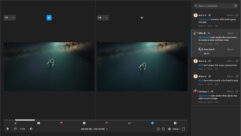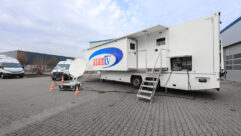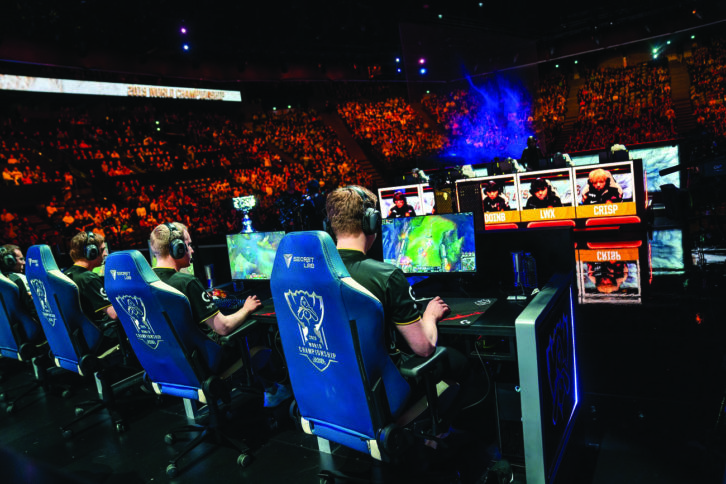
The popularity of eSports has reached fever pitch status with global viewership at an all-time high and showing no signs of slowing down. In fact, estimated revenues for multiplayer, often teambased, video game competitions are expected to exceed $1 billion this year, potentially doubling by 2022. In addition, traditional sports organizations, such as The NFL, NBA, NHL and MLS, are getting in on the eSports action with leagues or competitions focused on games of these genres. So eSports venues have been popping up worldwide.
As a result, competitions that were once only streamed on Twitch and YouTube are airing on traditional outlets like NBC, ESPN and ABC, and entertaining in-person fans. In the process, eSports are becoming a bigger part of the sports economy ecosystem.
These venues have specific technical needs and require a level of signal distribution, responsiveness, resolution, and distribution flexibility that actually goes beyond what is required of stadium AV for traditional sports.
One of the companies at the center of this emerging and powerful market is video game pioneer Riot Games. The LA-based company recognized the potential of eSports early on and has been helping develop the audience, establish leagues, and invest heavily in major competitions. In fact, the most-watched live eSports coverage in 2018 was Riot Games’ League of Legends (LoL), a multiplayer online battle arena (MOBA) game with 113 professional teams and over 850 salaried athletes. Overseen and operated by Riot Games, the full series of the tournament garnered a total audience of 347.4 million on Twitch and YouTube, and more than 23,000 fans packed into Incheon’s Munhak Stadium in South Korea for the final 2018 event, LoL Worlds.
At Riot Games HQ in Los Angeles, a central team designs and manages broadcasts for most of the big international events as well as the shows around North America and beyond the studio.
The Riot Games facility in L.A. was built around IHSE’s KVM platform for on-air control. There is a technical operations center, two control rooms, two audio controls, machine room, large analyst-desk studio with a couple of sets and the arena studio. For remote shows, the team uses one control room to produce the world feed, and then all the other regions build their shows on top of that.
The facility uses a 64-port IHSE Draco KVM matrix and Draco extenders, which connect the machines in the machine room to workstations in control rooms and elsewhere throughout the facility. That means the machines can remain in a climate-controlled environment where they won’t overheat and still get video, audio and control to wherever it’s needed. The count is constantly changing, but usually hovers around 50 to 60 computers and user stations connected at any time—so that’s always pushing that matrix to its limit.
The IHSE KVM provided them a platform that was easy to use and manage. New computers can be added and be running on the KVM matrix in 10 minutes or less. For the users, it feels like the computer is directly attached to their workstation; they don’t notice it’s hundreds of feet away, so it’s a seamless experience.
Having a system that is easy to deploy is especially helpful for the team on roadshows because of the tight schedule. Riot has a second matrix they sometimes take on the road with us, but often the IHSE extenders can operate without the matrix, so the travel team can carry a road case all racked up with the KVM extenders–just run a few Cat 5 cables to plug the extenders into. When the kit rolls back home, the extenders plug right back into our matrix.
Riot broadcast engineer Kris Johnson says the dual-purpose functionality is another great benefit of the IHSE system. “We get more for our investment, and we can travel with a much lighter kit and fewer people.
“The IHSE system is also flexible and easy to expand. For example, most of our systems use twisted-pair Cat 5 cables, but we recently implemented a couple fiber extenders for our on-air commentators, whose stations now have telestration that can’t operate over Cat 5 at that distance. “As for support, I couldn’t imagine a better working relationship.”
Riot also maintains 23 other offices worldwide, including the LoL European Championship Studio in Berlin, all interacting over a worldwide broadcast infrastructure. As a result, Riot has been employing REMI or ‘at-home’ remote audio and video production workflows for several years. This is to help support LoL’s free-to-play game-as-a-service (GaaS) model—a model that allows for the easy blending and multi-purposing of a business model that encompasses both amateur and professional athletes.
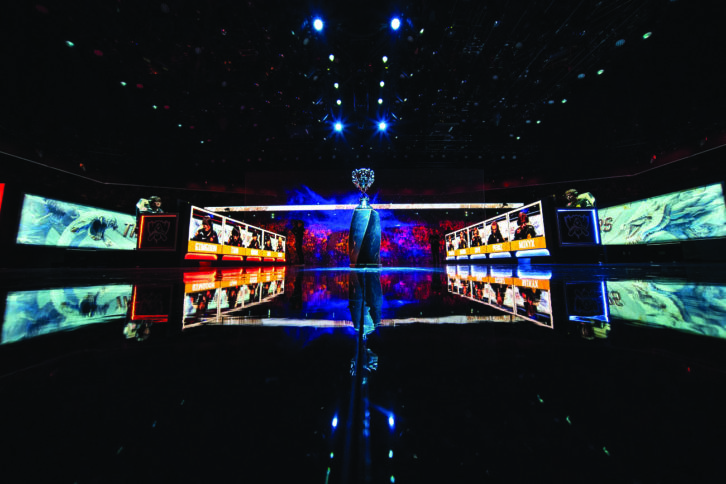
The GaaS model enables Riot Games to keep its fans engaged through constant improvements and updates, charging only for premium content. To support that cloud-based model, the company has built out a worldwide private network, the Riot Direct WAN, which interconnects its servers and offices with a broadband pipe. Part of that ISP’s bandwidth is reserved for production traffic, which is what allows Riot to remotely produce and broadcast events at venues around the world
Central to the system are Calrec’s IP-enabled consoles, which, for Riot, includes the Calrec Artemis console in the broadcast audio production room in Berlin, as well as a Calrec Brio, which serves as a monitor console for the players at that facility. The company also deploys a CEDAR system, to eliminate distracting crowd noise from players’ headsets.
With all aspects of Riot’s broadcast production, the focus is on constant evolution and iteration in the service of efficiency and resilience. Just as broadcast producers have had to find unique workflows and presentation solutions for individual traditional sports, so too must video game developers looking for ways to best present their specific competitions. For example, the company will produce the same event 15 times per tournament and never once do it the same way. The reason being is that there’s always a way to improve, always a change that’s going to deliver more value.
a team sport, and one of the key players is the IT department. When an international event is planned, the company’s network engineers create a direct pathway between a POP (point of presence) at a nearby Riot Games office from the Los Angeles POP over the enterprise WAN. Riot’s network engineers handle all the planning, routing, switching, InfoSec data security, monitoring and management of the infrastructure for each event. They also contract with local or regional service providers to connect over the last mile to the venue.
As Riot shifted its production formation to an “at-home” (aka in the studio) paradigm, the company knew it would need to begin a transition that would ultimately eliminate remote trucks from its workflow.
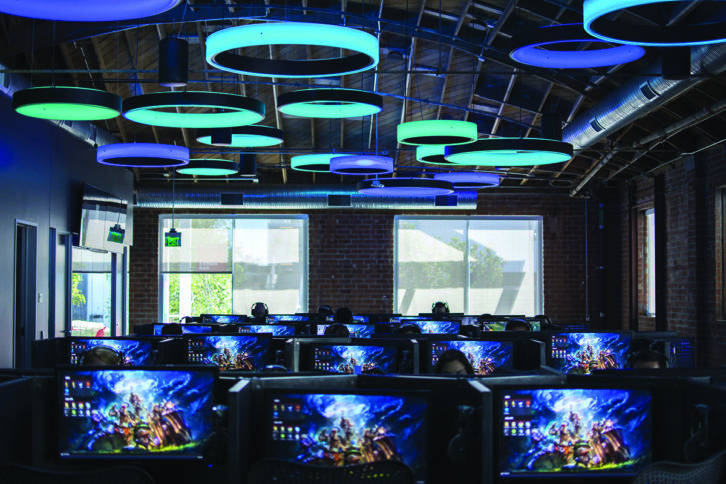 With Riot’s L.A. facility serving as the central station of its productions, everything from audio mixing and on-site camera control to director shot calls and video playback are routed through the site. While players are looking at their own game on their individual screens, three observers at Riot L.A. can position themselves anywhere within the game, following along and selecting action for replay in the broadcast from within the system, without disturbing the competitors, in addition to also feeding segments to EVS for replay.
With Riot’s L.A. facility serving as the central station of its productions, everything from audio mixing and on-site camera control to director shot calls and video playback are routed through the site. While players are looking at their own game on their individual screens, three observers at Riot L.A. can position themselves anywhere within the game, following along and selecting action for replay in the broadcast from within the system, without disturbing the competitors, in addition to also feeding segments to EVS for replay.
Recently, an international feed of a major championship tournament in Asia was generated using a switcher and audio room in L.A., which was subsequently distributed to every international partner. In this instance, Riot’s English-language announcers even called the action from a studio in L.A. rather than from the arena.
However, some functions are still handled locally at the individual venues. This includes redundant IFB mixes for the talent and competitors, who are on Dante-enabled wired packs from Studio Technologies, which also feed to the on-site console for fail-safe production. In addition to these tools, Riot uses Calrec’s new REMI audio products, such as the RP1 remote production unit with DSP, which allows latency-free IFBs to be generated at the remote site and subsequently controlled from a Calrec Artemis mixing console at the L.A. facility, which utilizes an in-house Riedel system for VoIP communications with the remote locations.
With 10 cameras dedicated to the two competing five-person teams, each event garners roughly 30 or more inbound live 1080p60 video and 40 audio input signals to L.A., with an additional 10-15 outbound video feeds for various purposes. During finals, which include opening ceremonies featuring live entertainment and musical performances, audio fills a 64-channel MADI stream.
Riot developed this groundbreaking at-home production infrastructure while simultaneously adopting a Haivision transport to significantly reduce bandwidth requirements. What once required 8.7Gb using JPG2000 compression over SONET lines has been reduced to 1.3Gb and now handles additional paths and encoders.
During the on-site production portions, audio is sent through a router and into a Nevion multi-format contribution codec, which encapsulates the MADI stream. In L.A., the incoming signals are routed to the Nevion decoders then into the Calrec mixing console. Video signals are converted to baseband and fed into the switcher, similar to the format of a production truck.
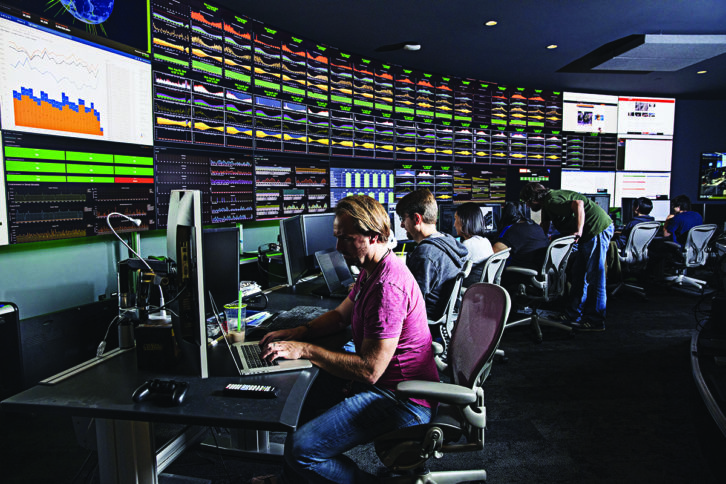 Working with IP transports also requires the production to carefully manage firewalls and potential IP address conflicts. When two back-to-back shows are leapfrogging, relevant production components must be on a separate address for each show. In some cases, Riot uses a 10.22 network, the class A block of IP space reserved for private networks worldwide, but the two productions can’t be tied together over the same address. So, for the second show, paths are assigned to different addresses, and the audio engineers subsequently manage their own switchovers.
Working with IP transports also requires the production to carefully manage firewalls and potential IP address conflicts. When two back-to-back shows are leapfrogging, relevant production components must be on a separate address for each show. In some cases, Riot uses a 10.22 network, the class A block of IP space reserved for private networks worldwide, but the two productions can’t be tied together over the same address. So, for the second show, paths are assigned to different addresses, and the audio engineers subsequently manage their own switchovers.
Of Riot’s 18 or so eSports distribution partners, only the four with the largest audiences can de-embed the multiple stems, ISOs and other sources necessary to build their own shows. Additionally, although surround formats are supported by Twitch and YouTube, events are currently produced in stereo as most partners can only take a two-channel mix, which are pulled from the Internet. People then watch the events on a variety of devices, including phones.
In this way, Riot is breaking down the walls of traditional sports broadcast workflows, which will result in more shows, games outlets and viewers.
JPEG XS and Remote Production
In using Nevion’s software-defined media node Virtuoso, Riot Games became one of the first organizations in the world to use the ground-breaking JPEG XS encoding technology.
This year’s League of Legends Word Championship, which took place in Paris last November, involved two remote production sites: the English language show was produced at Riot’s European headquarters facility in Berlin (over 620 miles from Paris), while the world feed was produced in Los Angeles (around 5,600 miles away)
For the event, Nevion Virtuosos provided the reliable, low latency video transport needed between Paris and the production locations, using the media node’s JPEG 2000 and JPEG XS encoding media functions running in the same units. While the former encoding technology is well established, the latter is a brand-new standard. JPEG XS achieves high-quality compression with ratios up to 10:1 at sub-millisecond latency, i.e. a fraction of a video frame – allowing gaming fans and players watching at home to see the action faster. For this production, the JPEG XS compressed video was transported using SMPTE ST 2110-22 over WAN (wide area network).
“The video signal looked quite amazing considering it was being sent from our studio in Santa Monica, to the venue in Europe and back through another return XS receive path into the studio,” says Michael Caal, Riot Games Technical Broadcast Manager. “Very crisp.





